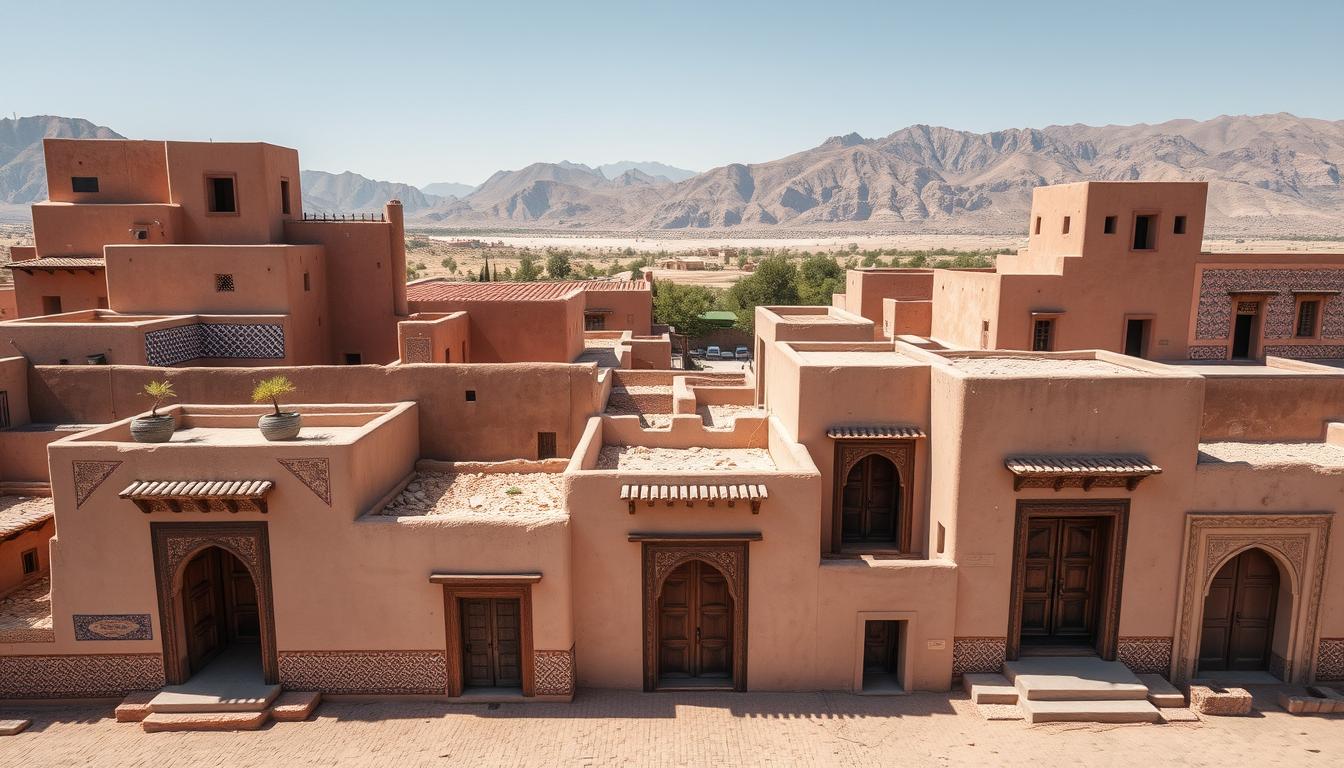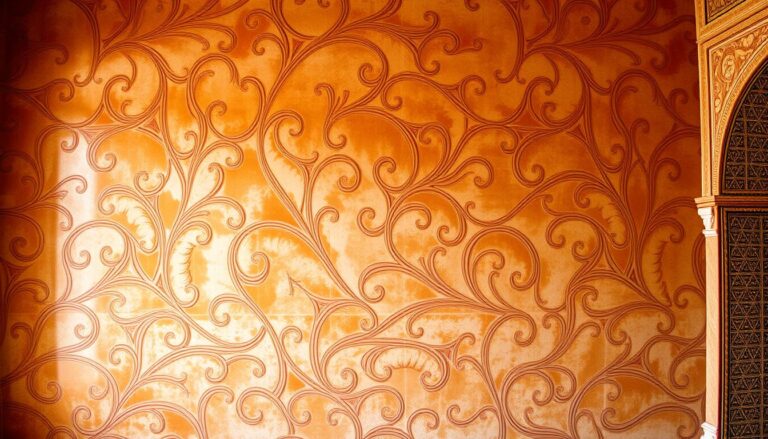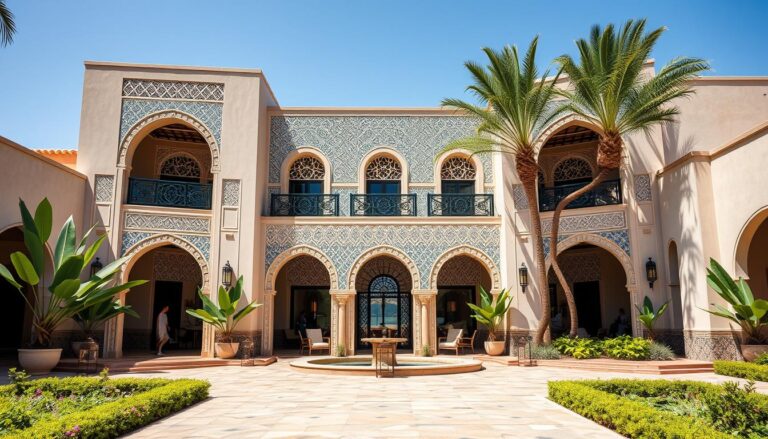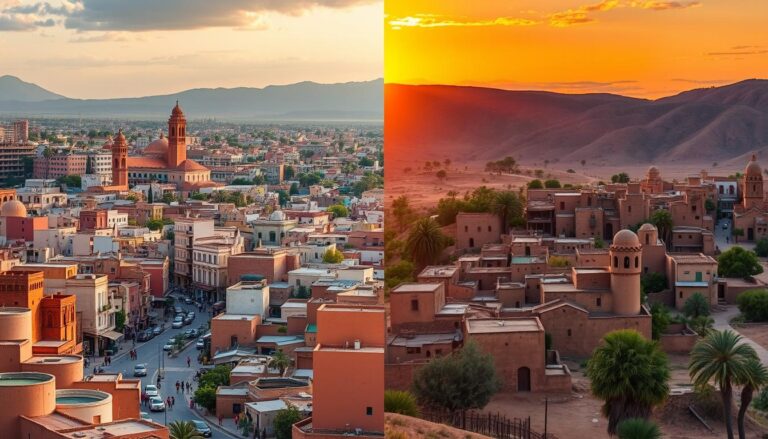Moroccan architecture is a captivating tapestry, woven with diverse cultural influences and rich natural resources. From ancient Roman ruins to the intricate Islamic motifs in Marrakesh’s mosques, Morocco’s architecture tells a long and storied history. Yet, a closer look reveals how geography, local materials, and traditional techniques shape each region’s unique architectural identity.
What factors have shaped Moroccan architecture’s regional variations? How do these material differences reflect the country’s cultural heritage and environmental diversity? Explore the captivating world of Moroccan architecture to discover the stories behind its bricks, stones, and tiles.
Key Takeaways
- Moroccan architecture is a tapestry of diverse cultural influences, from ancient Roman to modern French colonial styles.
- The regional variations in Moroccan architecture are closely tied to the country’s geography, local resources, and cultural traditions.
- Moroccan architecture features a blend of Islamic, Amazigh (Berber), and European architectural elements and motifs.
- Locally sourced materials, such as rammed earth, clay bricks, and stone, have shaped the distinct regional architectural styles in Morocco.
- Collaboration with knowledgeable local teams is crucial in navigating the cultural nuances and traditions that influence Moroccan architectural projects.
Introduction to Moroccan Architecture
Moroccan architecture is a rich mix of history and culture. It has been shaped by many rulers and cultures, from the ancient Berbers to the French colonists. You can see this in the ancient kasbahs, mosques, and palaces across the country.
Historical Influences and Cultural Diversity
Moroccan architecture reflects the country’s long history. The Islamicization of Morocco took centuries, with Islam becoming the main religion under the Idrisid Dynasty. This change is seen in the mix of Berber and Islamic design.
Over time, different dynasties like the Almoravid and the French colonial era have left their mark. The Ottoman Empire’s conquest of Fez in 1554 CE also influenced local styles. The French brought new designs and building methods.
Significance of Regional Material Variations
The different parts of Morocco show how geography and culture shape architecture. Rapid desertification made building materials scarce, leading to the use of rammed earth and mud brick.
The use of local materials like stone and wood is key to Moroccan architecture. This geographical sourcing creates a rich variety of regional material variations. It adds to the cultural richness of Moroccan buildings.
“Cultures are dynamic and require input from other cultures to thrive; isolation can hinder cultural development.”
Moroccan architecture shows the region’s resilience and ability to adapt. The balance between keeping traditions and embracing new ideas is a fascinating challenge.
Berber Architectural Traditions
The Berbers, or Imazighen, are an indigenous group in North Africa. They have made a lasting impact on the region’s buildings. They use rammed earth and clay bricks to build strong structures like kasbahs and ksour.
Rammed Earth and Clay Bricks
Berber buildings are known for using local materials. They dry pise (red mud clay bricks) in the sun. This method shows their connection to the land.
Their buildings, found in the Atlas Mountains and deserts, are very strong. They show how well the Berbers adapt to their environment.
Kasbahs and Fortified Villages
The Berbers are skilled in building kasbahs and ksour. These structures are built to last and keep people safe. They show the Berbers’ cleverness and focus on community.
Their buildings use materials found locally. This shows the Berbers’ rich cultural heritage.
“Berber architecture is a testament to the Imazighen’s enduring connection to the land, their resourcefulness, and their commitment to community.”
Islamic Architectural Elements
As Islam spread across North Africa, Morocco’s architecture changed a lot. It became very decorative and useful, showing a mix of Islamic styles. The key features are stunning geometric patterns, detailed zellij tilework, and famous domes, minarets, and horseshoe arches.
Geometric Patterns and Zellij Tilework
Geometric patterns are a big part of Moroccan Islamic architecture. They cover walls, floors, ceilings, and even fountains. These designs use zellij tilework, where small, glazed tiles are cut and arranged into complex shapes.
The zellij tiles come in colors like green, blue, brown, white, and black. These colors show the area’s unique materials and special designs.
Domes, Minarets, and Horseshoe Arches
Domes, minarets, and horseshoe arches are everywhere in Moroccan Islamic architecture. The tall minarets, like the one at the Hassan II Mosque in Casablanca, are both useful and symbolic. They call people to prayer and show off the area’s building skills.
The domes and horseshoe arches in mosques, palaces, and other buildings show great craftsmanship. They highlight the attention to detail that makes Moroccan design special.
“Moroccan architecture is a testament to the region’s rich cultural heritage, seamlessly blending Islamic, Berber, and Moorish influences into a truly unique and visually captivating aesthetic.”
Regional material variations in Moroccan Architecture
Locally Sourced Materials and Techniques
Moroccan architecture varies greatly due to the country’s diverse geography. Builders use materials and techniques specific to their region. For example, the Berber traditions in the Atlas Mountains and desert use rammed earth and clay bricks.
The use of locally sourced materials shows the creativity of Moroccan builders. They adapt to their local environment. The High Atlas’s clay and the Anti-Atlas’s limestone have shaped Morocco’s architectural styles.
Influence of Geography and Resource Availability
The influence of geography and resource availability is clear in Morocco’s architecture. In the desert, adobe and rammed earth keep buildings cool. Traditional plasters and paints add unique touches.
Materials like stone, wood, and bamboo also play a big role. They reflect the regional resource availability and the materials’ strengths. This makes each region’s architecture special.
Moorish and Andalusian Influences
Morocco’s architecture is deeply influenced by the Moors. They were an Islamic Berber population that shaped the region’s buildings. Their rule in Spain and Morocco for centuries left a lasting impact.
Moorish architecture in Morocco is known for its stucco facades, red-tiled roofs, and styles from Art Deco and Art Nouveau.
Stucco Facades and Courtyard Gardens
The Moors introduced key features to Moroccan architecture. These include clover-shaped and cusped arches, interior garden courtyards, and hand-glazed tiling, known as zellij. These elements blend tradition with modernity, showing Morocco’s rich cultural heritage.
“Moorish architecture in Morocco is a testament to the enduring legacy of the Moors, who left an indelible mark on the region’s built environment.”
The Moors used courtyard gardens and regional materials like stucco, clay, and tile. These materials add beauty and function to buildings. They adapt to the local climate and resources.
French Colonial Architecture
From 1912 to 1956, Morocco’s architecture changed a lot under French rule. The French brought in Art Deco and Art Nouveau styles. These styles mixed with Moroccan designs, creating a special Mauresque or Neo-Moorish look.
The French influence is seen in big, double French doors and windows. They also set strict building rules. But, they also kept Moroccan architectural features. This mix is seen in Rabat and Casablanca, showing Morocco’s architectural evolution.
“The architecture of Morocco during the French colonial era exemplified a fascinating interplay between French and traditional Moroccan styles, creating a rich and diverse cultural landscape.”
The French changed Morocco’s cities and buildings a lot. This time was full of cultural exchange. French designs mixed with Moroccan materials, creating a unique look that still shapes the area today.
Contemporary Moroccan Architecture
Modernist buildings are on the rise in Moroccan cities. Yet, the country’s architecture still reflects a mix of Berber, Islamic, Moorish, and French styles. Today’s Moroccan architecture tries to mix old and new, using geometric patterns, zellij tilework, and courtyard gardens with modern materials. This blend shows the regional material variations and cultural diversity that shape Morocco’s buildings.
Moroccan design is rich in vibrant colors, layered textures, and indoor-outdoor living spaces. Zellige tiles, Tadelakt plaster, and Berber rugs give homes and hotels a unique touch. These location-based material properties and regional resource availability have always influenced Moroccan architecture.
The charm of Moroccan design is loved in the United States. It’s known for glamor, comfort, and exotic appeal. Movies, TV shows, and the “Boho Chic” trend have made contemporary Moroccan architecture more popular. It’s a mix of old and new that people find fascinating.
Conclusion
Moroccan architecture is a rich mix of different cultures, geography, and history. It includes ancient Berber kasbahs, Islamic mosques, and French colonial buildings. These styles and materials show Morocco’s unique identity.
The importance of these materials lies in their ability to keep cultural stories alive. They also adapt to today’s needs and attract visitors worldwide. Traditional Moroccan building methods, like using khetaras and passive cooling, are valuable for solving today’s building challenges.
Moroccan architecture teaches us about blending cultural heritage, caring for the environment, and creative design. This legacy shows Morocco’s strength and ability to adapt over time. It makes Morocco a vibrant place that inspires people from all over the world.
Source Links
- Moroccan architecture
- Learning From Morocco – Avoid Obvious Architects
- Historic house architecture in Morocco
- Moroccan architecture
- Morocco’s Rich Architectural History
- WikiFreedom – Your AI-Powered Encyclopedia of Unbounded Knowledge
- Studio BO surfs through traditional Moroccan architecture for Tayourt
- Who Are the Berbers of Morocco? Unveiling North Africa’s Indigenous Secrets
- From Islamic to Art Deco: A rich history of Moroccan architecture
- Islamic arts – Moorish, Architecture, Decoration | Britannica
- Regional variations in vernacular architecture
- Proceedings of the GSAP 2006 Colloquium
- Moorish architecture
- Moorish Architecture in Andalusian Cities: A Deep Dive
- The Influence of French Colonialism on the Culture and Identity of Morocco and its People
- Urban design and architecture in the service of colonialism in Morocco
- Moroccan Interior Design 101 | Amity Worrel & Co.
- Moroccan Embroidery – (Islamic Art and Architecture) – Vocab, Definition, Explanations | Fiveable
- Tradition and Sustainability in Vernacular Architecture of Southeast Morocco
- An Investigation towards Optimizing the Construction Materials and Configurations of Buildings for Improving Energy Efficiency and Consumption in Morocco

The Editorial Team is a passionate group of Morocco enthusiasts dedicated to sharing the beauty, culture, and wonders of this captivating country. With diverse backgrounds and a deep love for travel, we strive to bring you engaging and informative content that inspires your Moroccan adventures. From uncovering hidden gems and sharing local insights to exploring mouthwatering cuisine and showcasing the vibrant lifestyle, our team is committed to providing you with valuable resources and exciting stories that enhance your exploration of Morocco. Join us on this journey as we celebrate the rich heritage and unforgettable experiences that make Morocco truly special.







